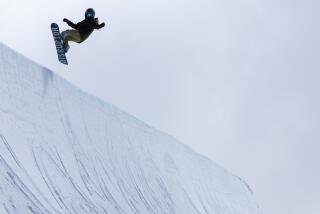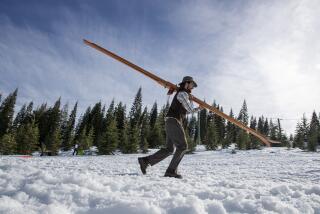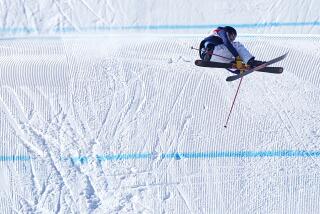Innovative Skis Pass Road Test
It took some time to get used to super-sidecut skis. They looked so odd. Fat tips, fat tails, narrow waist, like something manufactured in Toontown.
But by the end of my first turn, I was OK.
Some skiers might take a little longer. A run, maybe two. By then, anyone capable of sideslipping down even the most modest intermediate trail will realize that these skis are more than funny looking. They’re fun. They do precisely what you want at only the slightest suggestion. Put them on edge, and they can put you in paradise.
On a recent day trip to Bear Mountain, finding someone on shaped skis who didn’t like them was harder than finding someone who could spell Kjetil-Andre Aamodt. There hasn’t been so much universal fawning over a new product since itch-free long johns.
Beginning skiers are learning to carve turns more quickly and easily than on conventional skis, intermediates no longer see mogul fields as minefields, and aging experts still have their legs when the sun slips behind the mountain.
Steve Fox, 37, of Costa Mesa has been skiing for 30 years and has tried most of the high-performance shaped skis on the market. He says he’ll never go back.
“You find yourself skiing bump runs at 3 in the afternoon,” he said. “I never did that after I turned 30.”
Fox takes an annual ski trip with his buddies in search of altitude and steepness. They ski fast, spend plenty of time in the air and try to keep up with each other. His new skis help.
“They were instantly easier; you get more aggressive right away,” he said. “They change everything.”
Eric Sigdestad, a ski salesman at Sport Chalet in Brea, uses shaped skis and put his father on a pair recently.
“You can’t print this, but my dad is 54, and let’s just say form isn’t his forte,” he said. “Once he was on these skis, I actually started seeing him carving his turns, which is a nice change.”
(A couple of things, Eric: Your father said your quote was OK, and he’s only 53.)
Leonard Sigdestad, a veterinarian in Redlands who didn’t start skiing until he was 40, acknowledged the skis made a difference.
“They were fantastic,” he said. “So much easier. I skied steeper terrain with a lot more confidence. It turned skiing into fun.”
Travis Mason, a Bear Mountain instructor who has taught and coached racing at Mammoth Mountain, has seen young racers as well as less skilled skiers become enamored of the new skis.
“It’s not that they’re that different from conventional skis,” he said. “It’s just that while you’re on them, you’ve got power steering instead of a ’60 Volkswagen in the snow.”
At Bear Mountain, I spent about six hours on a pair of Dynastar Big Max 1 skis, which at 190 centimeters are 10 centimeters shorter than my normal length. As advertised, they turned very quickly, but also remained surprisingly stable and held their edge in high-speed, wider turns. They were like a Formula One race car tightly hugging a hairpin corner as opposed to a stock car fishtailing around a dirt track.
It was apparent right away that the skis want to be on their edges all the time; they want to string turns together, not go straight. When they ride flat on the snow, they’re a little squirrelly.
Shaped skis don’t demand radically different skills, but they perform best when the skier keeps pressure forward and weight over the center of the skis, and your weight can be more equally distributed to edges of both skis by keeping your feet a bit apart. Mason drove that point home in the few hours we spent together.
I was chastised repeatedly for my apparently outdated style of keeping my skis together. “Everybody used to try to do that Stein Eriksen thing,” he said. “Very stylish and everything, but if you get your feet apart, the skis will work that much better for you.”
Silly me, I thought they worked just fine.
Editor’s note: Mike James, a former member of the Mt. Mansfield Ski Patrol in Stowe, Vt., learned to ski in New England 30 years ago. He is trying to convince his wife that the racing skis he bought last season need to be replaced.



